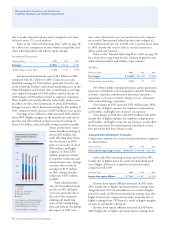Chevron 2011 Annual Report Download - page 28
Download and view the complete annual report
Please find page 28 of the 2011 Chevron annual report below. You can navigate through the pages in the report by either clicking on the pages listed below, or by using the keyword search tool below to find specific information within the annual report.
Management’s Discussion and Analysis of
Financial Condition and Results of Operations
26 Chevron Corporation 2011 Annual Report
Management’s Discussion and Analysis of
Financial Condition and Results of Operations
Dierences between the various assumptions used to
determine expense and the funded status of each plan and
actual experience are not included in benet plan costs in
theyear the dierence occurs. Instead, the dierences are
included in actuarial gain/loss and unamortized amounts
have been reected in “Accumulated other comprehensive
loss” on the Consolidated Balance Sheet. Refer to Note 21,
beginning on page 57, for information on the $9.6bil-
lion ofbefore-tax actuarial losses recorded by the company as
of December 31, 2011; a description of the method used to
amortize those costs; and an estimate of the costs to be rec-
ognized in expense during 2012.
Impairment of Properties, Plant and Equipment and
Investments in Aliates e company assesses its proper-
ties, plant and equipment (PP&E) for possible impairment
whenever events or changes in circumstances indicate that
the carrying value of the assets may not be recoverable. Such
indicators include changes in the company’s business plans,
changes in commodity prices and, for crude oil and natural
gas properties, signicant downward revisions of estimated
proved reserve quantities. If the carrying value of an asset
exceeds the future undiscounted cash ows expected from
the asset, an impairment charge is recorded for the excess of
carrying value of the asset over its estimated fair value.
Determination as to whether and how much an asset is
impaired involves management estimates on highly uncertain
matters, such as future commodity prices, the eects of ina-
tion and technology improvements on operating expenses,
production proles, and the outlook for global or regional
market supply-and-demand conditions for crude oil, natural
gas, commodity chemicals and rened products. However,
theimpairment reviews and calculations are based on
assumptions that are consistent with the company’s business
plans and long-term investment decisions. Refer also to the
discussion of impairments of properties, plant and equipment
in Note 9 beginning on page 42.
No major individual impairments of PP&E and Invest-
ments were recorded for the three years ending December
31, 2011. A sensitivity analysis of the impact on earnings for
these periods if other assumptions had been used in impair-
ment reviews and impairment calculations is not practicable,
given the broad range of the company’s PP&E and the
number of assumptions involved in the estimates. at is,
favorable changes to some assumptions might have avoided
the need to impair any assets in these periods, whereas unfa-
vorable changes might have caused an additional unknown
number of other assets to become impaired.
Investments in common stock of aliates that are
accounted for under the equity method, as well as invest-
ments in other securities of these equity investees, are
reviewed for impairment when the fair value of the invest-
ment falls below the company’s carrying value. When such a
decline is deemed to be other than temporary, an impairment
charge is recorded to the income statement for the dierence
between the investment’s carrying value and its estimated fair
value at the time.
In making the determination as to whether a decline is
other than temporary, the company considers such factors as
the duration and extent of the decline, the investee’s nan-
cial performance, and the company’s ability and intention
to retain its investment for a period that will be sucient to
allow for any anticipated recovery in the investment’s mar-
ket value. Diering assumptions could aect whether an
investment is impaired in any period or the amount of the
impairment, and are not subject to sensitivity analysis.
From time to time, the company performs impairment
reviews and determines whether any write-down in the carry-
ing value of an asset or asset group is required. For example,
when signicant downward revisions to crude oil and natural
gas reserves are made for any single eld or concession, an
impairment review is performed to determine if the carrying
value of the asset remains recoverable. Also, if the expectation
of sale of a particular asset or asset group in any period has
been deemed more likely than not, an impairment review is
performed, and if the estimated net proceeds exceed the car-
rying value of the asset or asset group, no impairment charge
is required. Such calculations are reviewed each period until
the asset or asset group is disposed of. Assets that are not
impaired on a held-and-used basis could possibly become
impaired if a decision is made to sell such assets. at is, the
assets would be impaired if they are classied as held-for-sale
and the estimated proceeds from the sale, less costs to sell,
are less than the assets’ associated carrying values.
Goodwill Goodwill resulting from a business combina-
tion is not subject to amortization. As required by accounting
standards for goodwill (ASC 350), the company tests such
goodwill at the reporting unit level for impairment on an
annual basis and between annual tests if an event occurs or
circumstances change that would more likely than not reduce
the fair value of a reporting unit below its carrying amount.
Contingent Losses Management also makes judgments
and estimates in recording liabilities for claims, litigation,
tax matters and environmental remediation. Actual costs can
frequently vary from estimates for a variety of reasons. For
























